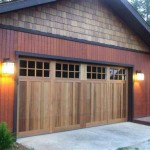What Is Standard Single Garage Door Size?
The size of a single garage door is a fundamental consideration when planning a home construction, renovation, or simply replacing an existing door. Understanding the standard dimensions not only simplifies the selection process but also ensures compatibility with the garage structure and the intended use of the space. While variations exist, adhering to common measurements offers numerous advantages, from cost-effectiveness to ease of installation and maintenance.
This article delves into the standard dimensions of single garage doors, exploring the common widths, heights, and the factors that influence these measurements. It also discusses the importance of accurate measurements and the implications of deviating from the established standards. Furthermore, it will explore common materials used to construct garage doors and their influence on overall dimensions and performance.
Common Width and Height Dimensions
The most frequently encountered standard width for a single garage door is 8 feet (96 inches or 244 cm). This width adequately accommodates most standard passenger vehicles, allowing for comfortable entry and exit. However, a slightly wider option, 9 feet (108 inches or 274 cm), is also prevalent and often preferred, particularly in newer constructions, as it provides additional clearance, reducing the risk of accidental scratches or dents to the vehicle.
In terms of height, the standard measurement is 7 feet (84 inches or 213 cm). This height is sufficient for accommodating most standard vehicles. However, as SUVs and trucks have gained popularity, a slightly taller option, typically 8 feet (96 inches or 244 cm), has become increasingly common. Choosing the appropriate height is crucial, especially if you intend to park taller vehicles or install a garage door opener system that might reduce the available headroom.
It's important to note that these dimensions are considered "nominal" sizes. This means the actual dimensions of the garage door might differ slightly, often by a few inches, to allow for proper fitting and operation within the garage door opening. The dimensions of the opening itself should be measured accurately to ensure a proper fit.
Factors Influencing Garage Door Size
Several factors can influence the choice of garage door size, beyond simply accommodating a vehicle. These factors often relate to the specific needs and preferences of the homeowner, the architectural style of the house, and the functional requirements of the garage space.
One primary factor is the size and type of vehicle to be stored. A homeowner with a larger SUV or truck will naturally require a taller door than someone with a compact car. Similarly, if the garage is intended to house multiple vehicles, a double garage door, which is significantly wider than a single, might be the more appropriate choice.
Another consideration is the intended use of the garage. If the garage is primarily used for parking, the standard sizes are usually adequate. However, if the garage is also used for storage, a workshop, or other purposes, a larger door might be desirable to facilitate the movement of larger items or equipment. Incorporating storage solutions like overhead racks might also influence the required height of the door.
The architectural style of the house also plays a significant role. The garage door should complement the overall design of the house and not appear disproportionate or out of place. In some cases, custom-sized doors might be necessary to achieve the desired aesthetic.
Furthermore, local building codes and regulations may impose specific requirements regarding garage door sizes, particularly in relation to accessibility and safety. It's essential to consult with local authorities or a qualified contractor to ensure compliance with all applicable regulations. For example, some areas require a certain clear height for handicap accessibility.
Implications of Deviating from Standard Sizes
While custom-sized garage doors offer flexibility and can cater to specific needs, deviating from standard sizes can have several implications that homeowners should consider. These often relate to cost, availability, and installation complexity.
One of the most significant is the increased cost. Custom-sized doors typically require specialized manufacturing processes, which translate to higher material and labor costs. In contrast, standard-sized doors are mass-produced, resulting in economies of scale that make them more affordable. This difference in cost can be substantial, especially for more elaborate designs or unconventional dimensions.
Another implication is the availability of components and accessories. Standard-sized doors use commonly available parts, making repairs and maintenance easier and more cost-effective. Finding replacement parts for custom-sized doors can be more challenging and time-consuming, potentially leading to longer downtime and higher repair costs. This includes things like springs, rollers, hinges, and even replacement panels.
Installation can also be more complex and time-consuming for custom-sized doors. Installers may need to make on-site modifications to the garage structure to accommodate the non-standard dimensions, adding to the overall installation costs. Furthermore, specialized equipment or techniques might be required, potentially limiting the availability of qualified installers.
Finally, resale value can be affected. While a custom-sized garage door might perfectly suit the current homeowner's needs, it might not appeal to future buyers. Standard-sized doors are generally considered more desirable due to their practicality and ease of maintenance, potentially making a custom-sized door a less attractive feature during a home sale. A standard-sized garage door appeals to a broader range of potential buyers.
Common Garage Door Materials and Their Influence
The material used to construct a garage door can significantly influence its overall dimensions, weight, durability, and insulating properties. The most common materials include steel, wood, aluminum, and fiberglass, each with its own advantages and disadvantages.
Steel garage doors are known for their strength, durability, and relatively low cost. They are typically constructed from multiple layers of steel, with an insulating core made of polyurethane or polystyrene foam. Steel doors are resistant to dents, rust, and weather damage, making them a durable option for most climates. However, they can be susceptible to scratches and may require occasional painting to maintain their appearance. The thickness of the steel can influence the overall weight of the door, potentially requiring a more powerful garage door opener.
Wood garage doors offer a classic and elegant aesthetic, providing a natural warmth and beauty that complements many architectural styles. They can be crafted from various types of wood, such as cedar, redwood, or hemlock, each with its own unique grain patterns and characteristics. Wood doors are highly customizable and can be stained or painted to match the home's exterior. However, they require regular maintenance to prevent warping, cracking, and rotting, and are generally more expensive than steel doors. The inherent weight of wood requires robust hardware and a suitably rated garage door opener.
Aluminum garage doors are lightweight, corrosion-resistant, and relatively inexpensive. They are often used in coastal areas where salt air can accelerate the corrosion of steel doors. Aluminum doors are typically constructed with an aluminum frame and panels made of aluminum, glass, or other materials. They are available in a wide range of styles and colors and require minimal maintenance. However, they are less durable than steel doors and are more prone to dents and damage. The lightweight nature of aluminum doors makes them easier to operate manually or with a less powerful opener.
Fiberglass garage doors are known for their durability, low maintenance, and resistance to moisture and rot. They are typically constructed with a fiberglass exterior and an insulating core made of polyurethane foam. Fiberglass doors can be designed to mimic the appearance of wood, providing the aesthetic benefits of wood without the associated maintenance requirements. They are also relatively lightweight and available in a variety of styles and colors. However, they can be more expensive than steel doors and may be susceptible to cracking in extreme temperatures. The dimensional stability of fiberglass makes it a good choice for doors in variable climates.
Regardless of the material chosen, it's crucial to consider the impact on the overall dimensions and weight of the garage door. Heavier doors, such as those made of solid wood or thick steel, may require a more powerful garage door opener and heavier-duty hardware to ensure safe and reliable operation. A professional garage door installer can assess the specific requirements and recommend the appropriate components for the chosen material and dimensions.

Standard Garage Door Sizes Single Double Roller Doors Sectional

What Are The Standard Garage Door Sizes Home Depot

An Introduction To Garage Door Sizes Continental

Residential Garage Doors Available Sizes Garaga

Average Garage And Doors Sizes In The Double Door

Standard Garage Door Dimensions And Sizes Ilrated With Diagrams For The Perfect Fit Single

What Size Garage Door Do I Need The Doorman Of Southeast Florida

Common Roller Garage Door Sizes Rollerdor Ltd

Standard Garage Door Sizes Single Double Roller Doors Sectional

Garage Door Dimensions Detailed Wessex Doors
Related Posts








